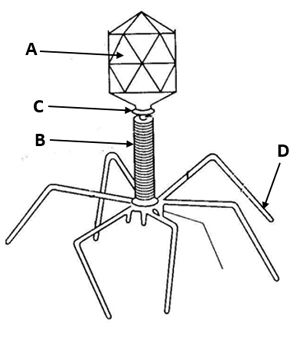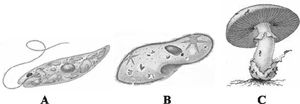A specimen of fungus is brought by a student for identification. Upon close examination, he discovered that its hyphae are completely septate and it has gills on the underside of the pileus. To which fungal group does it most likely belong ?
Basidiomycetes
Zygomycetes
Ascomycetes
Chytrids
Correct Answer :
A. Basidiomycetes
The pileus, or cap, is a common characteristic of the club fungi (basidiomycetes). The mycelium is branched and septate.
Related Questions
Mycorrhizae are useful for plants because they
fix atmospheric nitrogen.
enhance absorption of nutrients from the soil.
kill insects and pathogen.
provide resistance against abiotic stresses.
The figure given below shows the structure of a bacteriophage. Identify its parts labelled as A, B, C and D.

A - Tail fibres B - Head C - Sheath D - Collar
A - Sheath B - Collar C - Head D - Tail fibres
A - Head B - Sheath C - Collar D - Tail fibres
A - Collar B - Tail fibres C - Head D - Sheath
Match the terms given in column-I with their examples given in column-II and choose the correct option
| Column-I | Column-II |
|---|---|
| (Terms) | (Examples) |
| A. Ascus | I. Spirulina |
| B. Basidium | II. Penicillium |
| C. Protista | III. Agaricus |
| D. Cyanobacteria | IV. Euglena |
| E. Animalia | V. Sponges |
A II, B III, C IV, D V, E I
A I, B II, C III, D V, E IV
A II, B V, C III, D I, E IV
A II, B III, C IV, D I, E V
Which group of fungi is commonly known as imperfect fungi ?
Phycomycetes
Ascomycetes
Basidiomycetes
Deuteromycetes
Read the given statements and answer the question.
(i) It includes unicellular as well as multicellular fungi.
(ii) In multicellular forms hyphae are branched and septate.
(iii) Conidiophore produces conidia (spores) exogenously in chain.
(iv) Sexual spores are ascospores produced endogenously in chain.
(v) Fruiting body is called ascocarp.
Identify the correct class of fungi which have all the given characteristics.
Phycomycetes
Sac fungi
Club fungi
Fungi imperfecti
Which of the following statement is not correct for methanogens?
They are archaebacteria.
They live in marshy areas.
Methane is their preferred carbon source.
They are present in guts of several ruminant animals (cow, buffaloes) and produce biogas (CH4) from the dung of these animals.
Which of the following processes involved in the reproduction of protists ?
Binary fission and budding
Cell fusion and zygote formation
Spore formation and cyst formation
All of the above
The subunit of capsid is called
core
nucleotide
amino acid
capsomere
Which of the following is an example of amoeboid protozoans ?
Trypanosoma
Paramecium
Gonyaulax
Entamoeba
Match column I with column II and choose the correct option.
| Column I | Column II |
|---|---|
| A. Mycoplasma | (i) Nitrogen fixing cells |
| B. Decomposers | (ii) Blue green algae |
| C. Methanogens | (iii) Production of methane |
| D. Heterocysts | (iv) Most abundant heterotrophs |
| E. Cyanobacteria | (v) Pathogenic in plants and animals |
A-(i) B-(ii) C-(iii) D-(iv) E-(v)
A-(iii) B-(v) C-(ii) D-(iv) E-(i)
A-(iii) B-(i) C-(v) D-(ii) E-(iv)
A-(v) B-(iv) C-(iii) D-(i) E-(ii)
Bacteria and yeast are similar in all the following features except that
both are unicellular.
both are prokaryotes.
both are capable of causing fermentation.
both produce spores.
A specimen of fungus is brought by a student for identification. Upon close examination, he discovered that its hyphae are completely septate and it has gills on the underside of the pileus. To which fungal group does it most likely belong ?
Basidiomycetes
Zygomycetes
Ascomycetes
Chytrids
Why food can be kept for a longer time in cold house than in normal conditions ? Because,
insect cannot enter.
bacterial multiplication stops.
bacterial multiplication is reduced.
there is plasmolysis at low temperature.
Refer the given figure of bacteria cell and Nostoc and choose the option which shows correct label for the structure marked as A, B, C, D and E ?

A – Cell wall, B – Cell membrane, C – Heterocyst, D – DNA, E – Mucilagenous sheath
A – Cell wall, B – Cell membrane, C – DNA, D – Heterocyst, E – Mucilagenous sheath
A – Mucilagenous sheath, B – Cell membrane, C – DNA, D – Heterocyst, E – Cell wall
A – Cell membrane, B – Cell wall, C – DNA, D – Heterocyst, E – Mucilagenous sheath
Match the class of fungi given in column I with their examples given in column II and choose the correct option
| Column-I | Column-II |
|---|---|
| (Class of fungi) | (Examples) |
| A. Ascomycetes | I. Rhizopus |
| B. Basidiomycetes | II. Penicillium |
| C. Deuteromycetes | III. Ustilago |
| D. Phycomycetes | IV. Alternaria |
A IV, B III, C I, D II
A II, B III, C IV, D I
A IV, B I, C II, D III
A III, B IV, C II, D I
Choose the correct statements (i v) regarding mycoplasma
(i) Mycoplasma has no cell wall.
(ii) Mycoplasma is the smallest living organism.
(iii) Mycoplasma cannot survive without O2.
(iv) Mycoplasma are pathogenic in animals and plants.
(v) A sort of sexual reproduction occurs in bacterium by adopting a primitive DNA transfer from one bacterium to the other.
Only (iii)
(i), (iii) and (v)
(i), (ii), (iv), and (v)
All of the above
A virus can be considered a living organism because it
responds to touch stimulus
respires
reproduces (inside the host)
can cause disease
Which of the following statement(s) is/are correct about ascomycetes ?
(i) Neurospora, which is used in biochemical and genetic work is a member of this class.
(ii) They are mostly multicellular, e.g., Yeast, or rarely unicellular, e.g., Penicillium.
(iii) They are saprophytic, decomposers, parasitic or coprophilous.
(iv) Some examples are Aspergillus, Claviceps and Neurospora.
Both (i) and (ii)
Only (ii)
(i), (iii) and (iv)
All of these
Read the following statements and answer the question.
(i) Some members are saprophytes or parasites while a large number of them are decomposers of litter and help in mineral cycling.
(ii) They reproduce only by asexual spores known as conidia.
(iii) Mycelium is septate and branched.
(iv) Alternaria, Colletotrichum and Trichoderma are examples of this class.
Which of the following class of fungi is being described by the above statements ?
Phycomycetes
Deuteromycetes
Basidiomycetes
Ascomycetes
Which of the following pairs comes under the group chrysophytes ?
Diatoms and Euglena
Euglena and Trypanosoma
Diatoms and Desmids
Gonyaulax and Desmids
Which of the following statement(s) is/are correct about class basidiomycetes ?
(i) They are commonly known as imperfect fungi because only the asexual or vegetative phases of these fungi are known.
(ii) They grow in soil, on logs and tree stumps and in living plant bodies as parasites, e.g., rusts and smuts.
(iii) The mycelium is branched and septate.
(iv) Some common members are Agaricus, Ustilago and Puccinia.
Only (i)
Both (ii) and (iii)
(ii), (iii) and (iv)
All of these
Which of the following pair is correctly matched ?
Fungi Saprophytic parasitic mode of nutrition.
Monera Nuclear membrane is present.
Plantae Cell wall is made up of cellulose.
Animalia Cell wall is absent.
Bladderwort and Venus fly trap are examples of
insectivorous plants
parasitic plants
N2 rich plants
aquatic plants
Which of the following class of fungi is being described by the given statements ?
(i) They are found in aquatic habitats and on decaying wood in moist and damp places.
(ii) Mycelium is aseptate and coenocytic.
(iii) Asexual reproduction takes place by zoospores (motile) or by aplanospores (non-motile).
(iv) Some common examples are Mucor, Rhizopus and Albugo.
Ascomycetes
Phycomycetes
Basidiomycetes
Deuteromycetes
Which of the following statements regarding cyanobacteria is incorrect?
It is also called blue green algae.
They are chemosynthetic autotrophs.
It forms blooms in polluted water bodies.
It is unicellular, colonial or filamentous, marine or terrestrial bacteria.
In some viruses, RNA is present instead of DNA indicating that
their nucleic acid must combine with host DNA before replication.
they cannot replicate.
there is no hereditary information.
RNA can transfer heredity material.
Match the characters given in column I with their examples given in column II.
| Column I | Column II |
|---|---|
| A. Long slender thread | (i) Lichen like structures |
| B. Association of fungi with | (ii) Mycorrhiza roots of higher plants |
| C. Parasitic fungi on mustard | (iii) Neurospora |
| D. Fungi extensively used in | (iv) Albugo biochemical and genetic work |
| E. An association in which | (v) Hyphae algal component is called phycobiont |
A-(v) B-(ii) C-(iv) D-(iii) E-(i)
A-(iii) B-(i) C-(iv) D-(ii) E-(v)
A-(ii) B-(i) C-(iii) D-(v) E-(iv)
A-(iii) B-(ii) C-(iv) D-(i) E-(v)
Which of the following statement is/ are correct for bacteria ?
They are the members of the kingdom monera.
They live in extreme habitats such as hot springs, deserts, snow and deep oceans.
They show the most extensive metabolic diversity.
All of the above
Match the type of protozoans given in column-I with their examples given in column-II and choose the correct option.
| Column-I | Column-II |
|---|---|
| (Type of Protozoans) | (Examples) |
| A. Amoeboid protozoans | I. Paramecium |
| B. Ciliated protozoans | II. Plasmodium |
| C. Flagellated protozoans | III. Amoeba |
| D. Sporozoans | IV. Trypanosoma |
A I; B III; C IV; D II
A III; B I; C II; D IV
A III; B I; C IV; D II
A III; B IV; C I; D II
Identify the following figures A, B and C.

A – Euglena, B – Paramecium, C – Agaricus
A – Euglena, B – Planaria, C – Agaricus
A – Planaria, B – Paramecium, C – Agaricus
A – Euglena, B – Paramecium, C – Aspergillus
